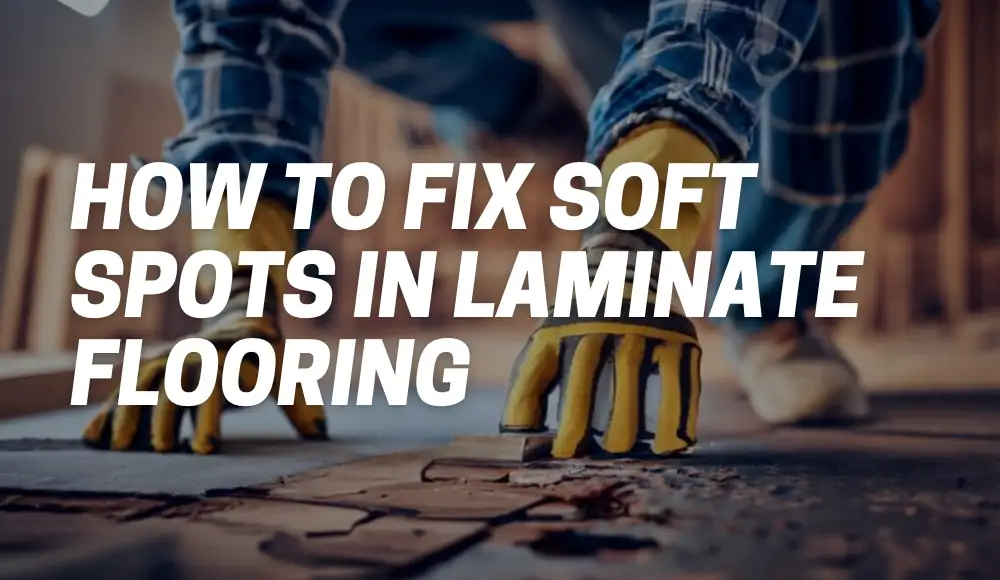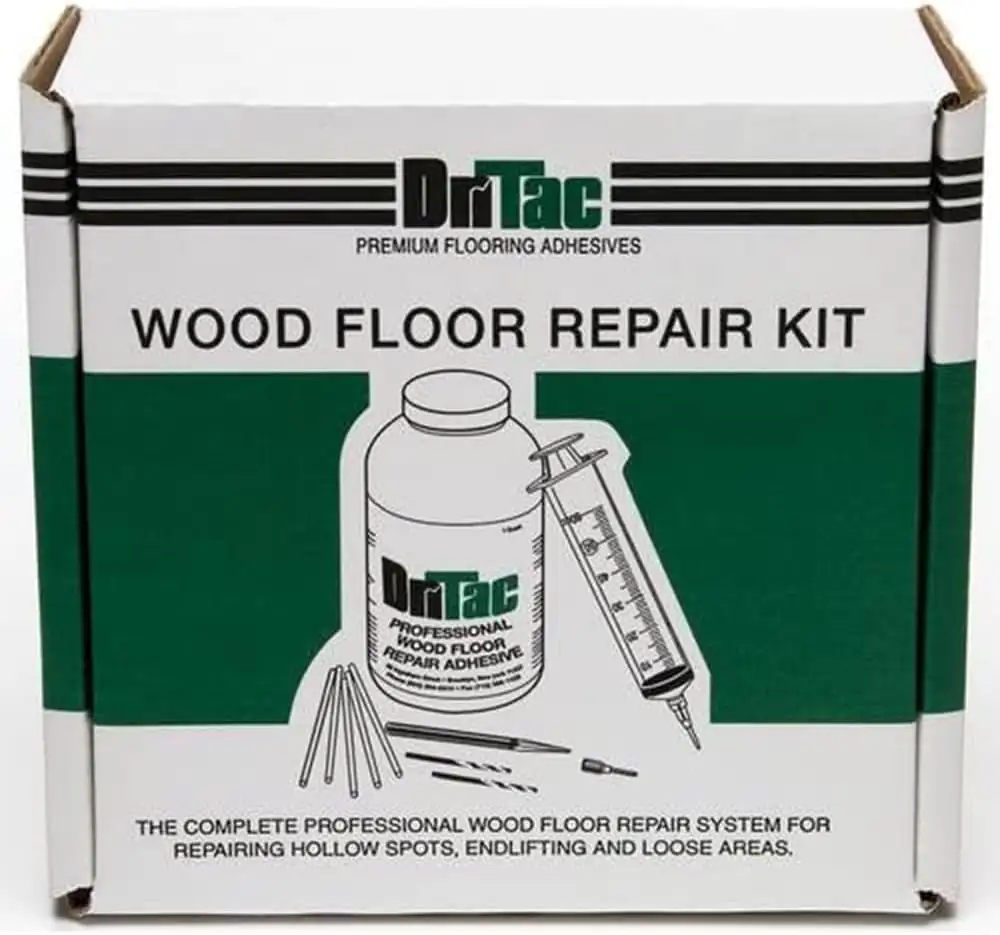Last updated on October 28th, 2023 at 01:03 pm
Soft spots in laminate flooring can be a real headache. That spongy feeling underfoot, the visual distortion of your beautiful flooring, and the nagging worry about potential damage – it’s not a situation anyone wants to deal with. But fret not, because in this comprehensive guide, we will walk you through everything you need to know about fixing those pesky soft spots in your laminate flooring. From why they occur to DIY solutions and professional services, we’ve got you covered.
Let’s dive in.
Why Does My Laminate Floor Feel Spongy?
Have you ever wondered why your once-sturdy laminate flooring now feels spongy and soft in certain areas? There can be several reasons behind this disconcerting phenomenon:
Water Damage
One of the most common culprits for soft spots in laminate flooring is water damage. Whether it’s from a plumbing leak, a spilled drink that went unnoticed, or even excessive humidity in the room, moisture can seep into the seams of laminate planks. Over time, this causes the core of the laminate to swell and soften, leading to that spongy feeling underfoot.
Improper Installation
Another potential reason for soft spots is improper installation. If the subfloor wasn’t adequately prepared, if there were gaps left between planks during installation, or if the flooring wasn’t acclimated to the room’s conditions, it can result in an uneven surface with weak points.
Subfloor Issues
Sometimes, the problem lies not with the laminate flooring itself, but with the subfloor beneath it. If the subfloor is uneven, contains soft spots of its own, or has structural issues, these problems can manifest as soft spots in your laminate flooring.
Can I Fix Soft Spots in Laminate Flooring Myself?
The good news is that in many cases, you can tackle soft spots in your laminate flooring on your own, provided you’re a bit handy and have the right tools. Here’s what you’ll need:
- Laminate Adhesive: This is crucial for reattaching the laminate planks to the subfloor.
- A Utility Knife: You’ll use this to cut and remove damaged sections.
- Replacement Planks: You’ll need new laminate planks to replace any irreparably damaged ones.
How Do I Identify Soft Spots in Laminate Flooring?
Recognizing soft spots in your laminate flooring is essential before you can begin repairs. Here are some methods:
- Visual Inspection: Look for areas where the laminate seems uneven, warped, or has visible damage.
- Touch Inspection: Walk around on the floor and pay attention to any areas that give way or feel spongy under your weight.
Should I Repair or Replace Laminate Flooring with Soft Spots?
The decision to repair or replace your laminate flooring depends on the extent of the damage. If only a small section is affected, repairing it might be the best course of action. However, if the damage is widespread or the soft spots are a recurring issue, it’s often more practical to replace the entire floor.
What Are the Steps to Fix Soft Spots in Laminate Flooring?
If you’ve decided to repair your laminate flooring, here’s a step-by-step guide to help you through the process:
Step 1: Subfloor Preparation
- Begin by ensuring that the subfloor is clean, dry, and free from any debris.
- Check the subfloor for any irregularities, such as soft spots, and address them if needed.
Step 2: Remove Damaged Planks
- Use a utility knife to carefully cut and remove the damaged laminate planks.
- Take care not to damage the surrounding planks during this process.
Step 3: Apply Laminate Adhesive
- Apply laminate adhesive to the exposed subfloor.
- Carefully place the replacement planks into the adhesive, ensuring they are flush with the existing flooring.
Step 4: Reinstallation
- Gently walk on the repaired area to ensure the planks adhere properly.
- Allow adequate drying time as per the adhesive manufacturer’s instructions before using the repaired area.
—
What Materials Do I Need for Laminate Flooring Repairs?
Here’s a list of materials you’ll need for laminate flooring repairs:
- Laminate adhesive
- A utility knife
- Replacement laminate planks
- A notched trowel
- A roller for applying pressure to the repaired area
What Is a Laminate Floor Injection Kit?
A Laminate Floor Injection Kit is a specialized tool designed for repairing soft spots in laminate flooring. It typically includes a syringe-like injector that allows you to inject adhesive under the laminate plank, effectively reattaching it to the subfloor.
—
This kit can be handy for spot repairs and is available at most home improvement stores.
How to Fix Soft Spots in Laminate Flooring Naturally
For those who prefer a more natural approach, you can try addressing soft spots with a few DIY tricks:
- Weight Distribution: Place heavy objects over the soft spots for a few days. This can sometimes help the laminate reattach to the subfloor as it settles.
- Increase Ventilation: If moisture is the issue, improving ventilation in the room can help reduce humidity and aid in the drying process.
How to Fix Soft Spots in Laminate Flooring on Concrete
When dealing with soft spots on a concrete subfloor, it’s crucial to address any moisture issues first. Ensure that the concrete is completely dry before attempting any repairs. The repair process is similar to that on a wooden subfloor, as outlined earlier.
How to Fix Soft Spots in Laminate Flooring: User Advice
Sometimes, the best advice comes from those who have experienced the same issues. Here are a few user-provided tips:
| Approach/Method | Key Points |
|---|---|
| Injecting Foam | Inject foam into the soft spots by drilling holes around the area. Use the right amount to avoid over-expansion. |
| Use Foam for Concrete and Dricore | To level the concrete and dricore, inject foam through the floor and dricore using appropriate materials. |
| Professional Injection and Sealing | Some professionals inject foam and then seal the entire floor, often using polyurethane, to maintain the integrity of the repair. |
| Accessing From the Underside | If you can access the underside, inject non-expanding foam through drilled holes and place a little weight on top to keep it level. |
| Support or Shim the Floor from Below | If possible, jack, shim, or support the floor from below to remove the soft spots. This may involve removing voids. |
| Patch with Adhesive and Plywood | Fill the voids with non-expanding foam through drilled holes, then patch the holes with matching plugs or adhesive. |
| Drilling Multiple Holes | Instead of filling the void through one hole, drill multiple holes 3-4 inches apart to ensure even filling. Tape the holes afterward. |
- Regular Maintenance: Keep your laminate flooring clean and dry, and address spills and leaks promptly.
- Area Rugs: Place area rugs in high-traffic areas to reduce wear and tear on the laminate.
- Humidity Control: Use a dehumidifier to maintain an optimal indoor humidity level, especially in areas prone to moisture.
How Can I Prevent Soft Spots in the Future?
Prevention is always better than the cure. To avoid soft spots in your laminate flooring, consider these tips:
- Proper Installation: Ensure your laminate flooring is installed correctly, with a level subfloor and the right acclimation process.
- Moisture Management: Take precautions to prevent water damage, such as using moisture barriers and promptly addressing spills.
- Regular Maintenance: Keep your flooring clean, and inspect it regularly for any signs of damage.
Can Soft Spots in Laminate Flooring Be Fixed Without Removing the Entire Floor?
Yes, in many cases, you can fix soft spots without removing the entire floor. Spot repairs, using the techniques mentioned earlier, can be effective in addressing localized issues without the need for a full replacement.
What Are the Costs Associated with Fixing Soft Spots in Laminate Flooring?
The cost of fixing soft spots in laminate flooring can vary widely. DIY repairs are generally cost-effective, with the main expenses being adhesive and replacement planks. Professional services can range from a few hundred to a few thousand dollars, depending on the extent of the damage.
What Should I Do If Soft Spots Reoccur After Repair?
If soft spots reoccur after a repair, it’s essential to identify and address the underlying issue. It may be a recurring moisture problem, subfloor instability, or a fault in the original laminate installation. Identifying the root cause is crucial to preventing further issues.
Is It Possible to Refinish Laminate Flooring to Repair Soft Spots?
Refinishing laminate flooring is not a common practice because laminate is a thin, non-repairable surface. If you have soft spots, it’s usually more effective to address the problem directly by repairing or replacing the affected planks.
How Long Does It Take to Fix Soft Spots in Laminate Flooring?
The time it takes to fix soft spots in laminate flooring can vary depending on the extent of the damage, the adhesive drying time, and the complexity of the repair. Typically, repairs can take a few hours to a day, with additional time needed for adhesive curing.
Are There Professional Services Available for Fixing Soft Spots in Laminate Flooring?
Yes, there are professional services available for fixing soft spots in laminate flooring. These services often include experienced technicians who can assess and repair the damage, ensuring a high-quality and long-lasting solution. Costs may vary, so it’s advisable to obtain multiple quotes before proceeding.
Remember that when it comes to soft spots in your laminate flooring, it’s essential to act promptly and choose the most suitable repair method based on the severity of the issue. Whether you opt for a DIY approach or seek professional assistance, a well-executed repair will restore the beauty and functionality of your flooring, making your home a comfortable and inviting space once more.
For more information and expert advice, be sure to check out these authoritative sources:
Now, armed with the knowledge to address soft spots in your laminate flooring, you can step confidently towards a solution that suits your needs and your budget.



